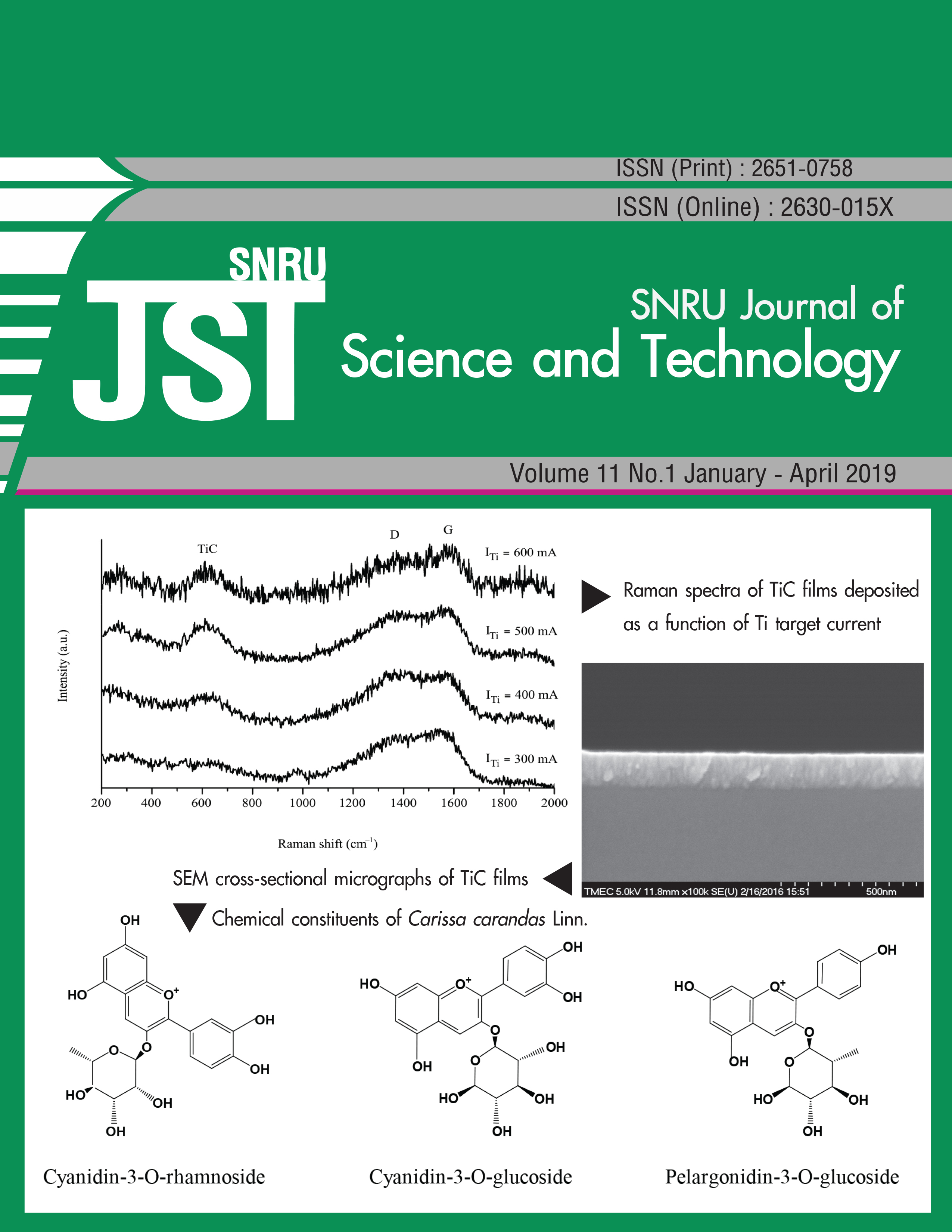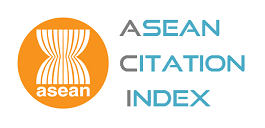Antibacterial activity against some human pathogenic bacteria and anti-inflammatory activity of five Thai medicinal plant extracts
Keywords:
Antibacterial activity, Anti-inflammatory, Human pathogenic bacteria, Thai medicinal plantAbstract
Microbial infections often produce pain and inflammation. Inflammation is one common and major cause of sufferings now and every time past. Thai medicinal plants which possess biological activities are potential to develop an alternative agent in pharmaceutical products. This study aims to investigate the antibacterial and anti-inflammatory activities of the aqueous, ethanolic and methanolic extracts from five Thai medicinal plants (Tristaniopsis burmanica, Capparis zeylanica Linn., Markhamia stipulata, Caryota maxima and Amphineurion marginatum). Five Thai medicinal plant extracts were subjected to evaluation of their antibacterial activity against four human pathogenic bacteria, including Vibrio cholerae (clinical), Staphylococcus aureus ATCC25923, Staphylococcus epidermidis ATCC12228 and Escherichia coli ATCC25922 using the agar well diffusion method. The ethanolic and methanolic extracts of five Thai medicinal plants showed capable of inhibiting the growth of one or more tested bacteria. The analysis of the minimum inhibitory concentrations (MICs) which inhibited the four pathogenic bacteria using the broth microdilution assay showed that MICs of the ethanolic and methanolic extracts were ranging from 0.63 mg mL−1 to >10 mg mL−1. Additionally, the anti-inflammatory activity of the extracts was studied using murine macrophage (RAW 264.70) as a model. The results show that the ethanolic and methanolic extracts of Caryota maxima and Amphineurion marginatum showed anti-inflammatory activity by reduced nitric oxide (NO). Also most of the extracts were not toxic to RAW 264.70 cells. The bioactive compounds analysis of the ethanolic and methanolic extract of Amphineurion marginatum was carried out using Gas chromatography-mass spectrometry (GC-MS). The results revealed dominant components were phenol, 3׳-Acetyllycopsamine and lupeol. So, the results of this research directly indicate that the Amphineurion marginatum extracts provide both antibacterial and anti-inflammatory activities, which could be used as a supplementary agent in pharmaceutical products.
References
2.J.Y. Guo, H.R. Huo, L.F. Li, S.Y. Guo, T.L. Jiang, Sini tang prevents depression-like behavior in rats exposed to chronic unpredictable stress, Am. J. Chin. Med. 37 (2009) 261 − 272.
3.J.N. Eloff, Which extractant should be used for the screening and isolation of antimicrobial components from plants?, J. Ethanopharmacol. 60 (1998) 1 − 8.
4.D. Amenu, Antimicrobial Activity of Medicinal Plant Extracts and Their Synergistic Effect on Some Selected Pathogens, Am. J. Ethnomed. 1 (2014) 18 – 29.
5.A. Segura, M. Moreno, A. Molina, F. Garcia-Olmedo, Novel defensin subfamily from spinach (Spinacia oleracea), FEBS Lett. 435 (1998) 159 − 162.
6.K. Kazłowska, T. Hsu, C.C. Hou, W.C. Yang, G.J. Tsai, Anti-inflammatory properties of phenolic compounds and crude extract from Porphyra dentata, J. Ethnopharmacol. 128 (2010) 123 − 130.
7.C.E. Maddox, L.M. Laur, L. Tian Antibacterial activity of phenolic compounds against the phytopathogen Xylella fastidiosa, Curr. Microbiol. 60 (2010) 53 – 58.
8.J.S. Deng, C.S. Chi, S.S. Huang, P.H. Shie, T.H. Lin, G.J. Huang, Antioxidant, analgesic, and anti-inflammatory activities of the ethanolic extracts of Taxillus liquidambaricola, J. Ethnopharmacol. 137 (2011) 1161 − 1171.
9.T. Yu, H.M. Ahn, T. Shen, K. Yoon, H.J. Jang, Y.J. Lee, H.M. Yang, J.H. Kim, C. Kim, M.H. Han, S.H. Cha, T.W. Kim, S.Y. Kim, J. Lee, J.Y. Cho, Anti-inflammatory activity of ethanol extract derived from Phaseolus angularis beans, J. Ethnopharmacol. 137 (2011) 1197 – 1206.
10.C. Han, J. Guo. Antibacterial and Anti-inflammatory Activity of Traditional Chinese Herb Pairs, Angelica sinensis and Sophora flavescens, Inflammation. 35 (2012) 913 − 919.
11.S. Thummajitasakul, L. Tumchalee, S. Koolwong, P. Deetae, W. Kaewsri, S. Lertsiri, Antioxidant and antibacterial potentials of some Thai native plant extracts, Int. Food. Res. J. 21 (2014) 2393 − 2398.
12.C. Moro, I. Palacios, M. Lozano, M. D’Arrigo, E. Guillamo´n, A. Villares, J.A. Martínez, A. García-Lafuente, Anti-inflammatory activity of methanolic extracts from edible mushrooms in LPS activated RAW 264.7 macrophages, Food Chem. 130 (2012) 350 – 355.
13.A. Sakunpak, P. Panichayupakaranant, Antibacterial activity of Thai edible plants against gastrointestinal pathogenic bacteria and isolation of a new broad spectrum antibacterial polyisoprenylated benzophenone, chamuangone, Food Chem. 130 (2012) 826 – 831.
14.J.F. Höfling, P.C. Anibal, G.A. Obando-Pereda, I.A.T. Peixoto, V.F. Furletti, M.A. Foglio, R.B. Gonçalves, Antimicrobial potential of some plant extracts against Candida species, Braz. J. Biol. 70 (2010) 1065 − 1068.
15.C. Ya, S. Gaffney, H.T.H. Lilley, E. Haslam, Carbohydratepolyphenol complexation, in: R.W. Hemingway, J.J. Karchesy (Eds.), Chemistry and Significance of Condensed Tannins, Plenum Press, New York, 1988, pp. 553.
16.S. Moncada, R.M. Palmer, E.A. Higgs, Biosynthesis of nitric oxide from L-arginine: a pathway for the regulation of cell function and communication. Biochem, Pharmacol. 38 (1989) 1709 − 1715.
17.C. Bogdan, Nitric oxide and the immune response, Nat. Immunol. 2 (2001) 907 − 916.
18.H. Leontowicz, M. Leontowicz, P. Latocha, I. Jesion, Y.S. Park, E. Katrich, D. Barasch, A. Nemirovski, S. Gorinstein, Bioactivity and nutritional properties of hardy kiwi fruit Actinidia arguta in comparison with Actinidia deliciosa ‘Hayward’ and Actinidia eriantha ‘Bidan’, Food Chem. 196 (2016) 281 − 291.
19.A.J. Hobbs, A. Higgs, S. Moncada, Inhibition of nitric oxide synthase as a potential therapeutic target, Annu. Rev. Pharmacol. Toxicol. 39 (1999) 191 – 220.
20.X. An, S.G. Lee, H. Kang, H.J. Heo, Y.S. Cho, D.O. Kim, Antioxidant and Anti-Inflammatory Effects of Various Cultivars of Kiwi Berry (Actinidia arguta) on Lipopolysaccharide-Stimulated RAW 264.7 Cells, J. Microbiol. Biotechnol. 26 (2016) 1367 – 1374.
21.M. Saleem, Lupeol, a novel anti-inflammatory and anti-cancer dietary triterpene, Cancer Lett. 285 (2009) 109 − 15.








